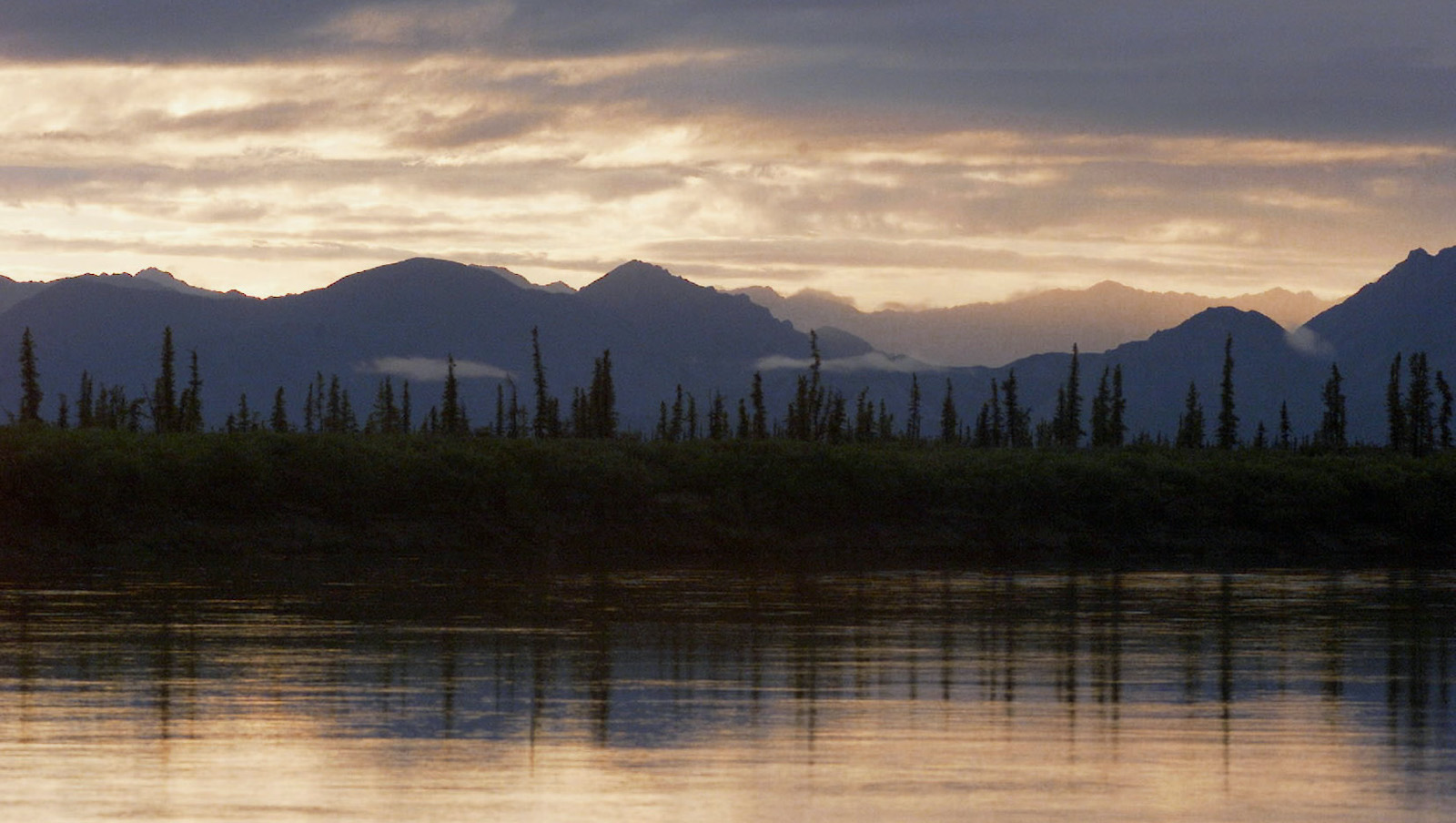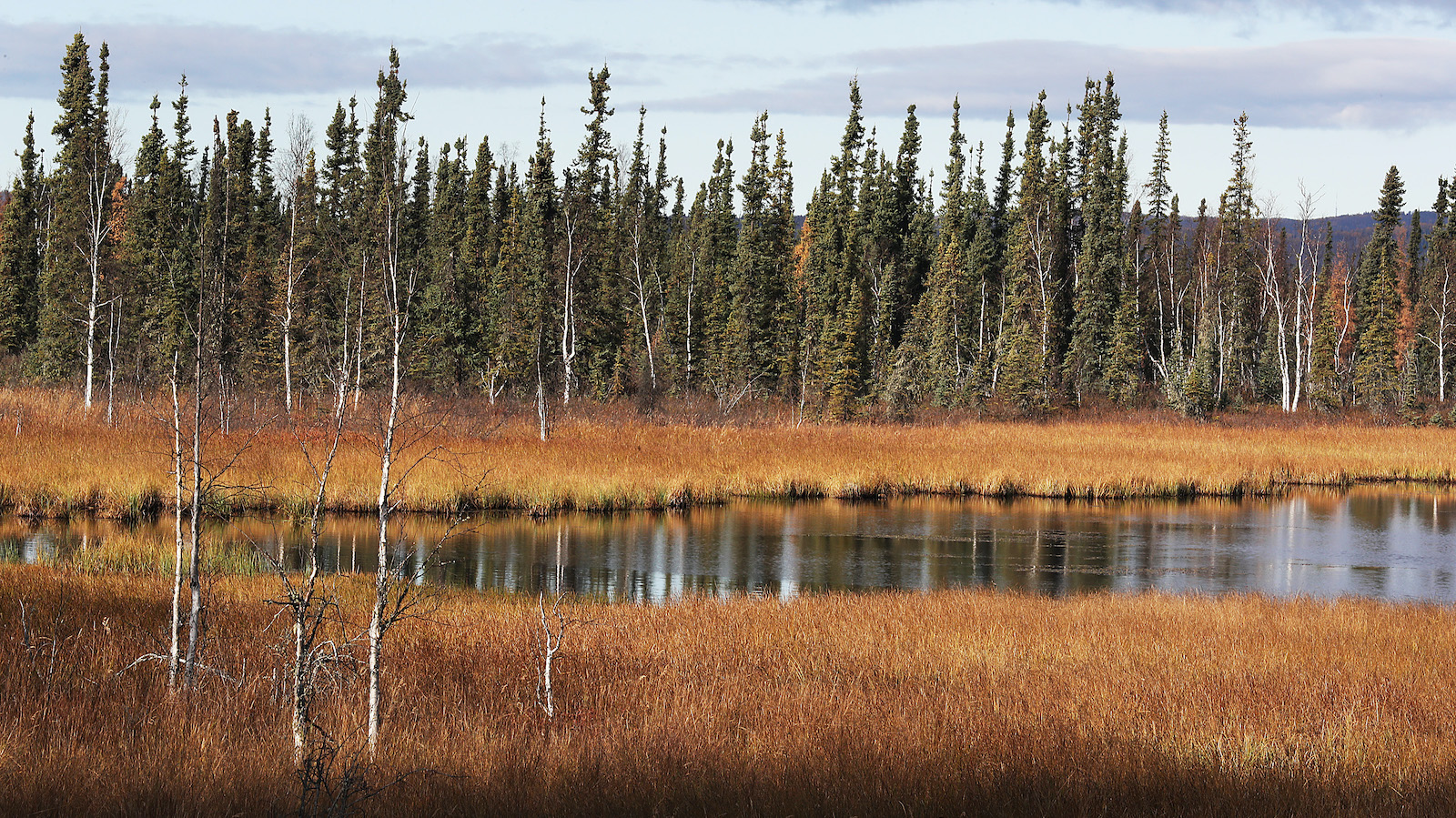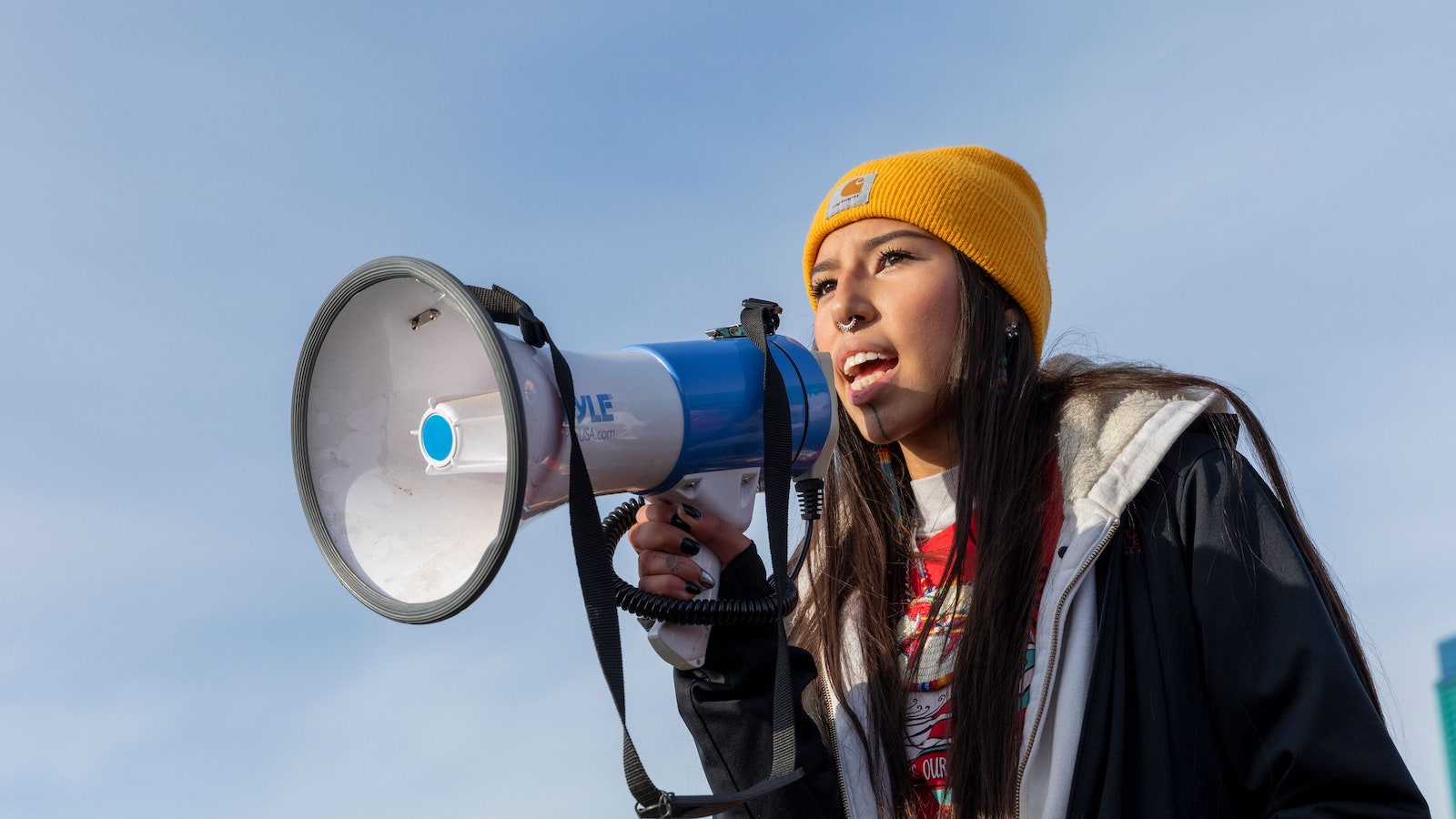This story originally appeared in Teen Vogue and is republished here as part of Covering Climate Now, a global journalism collaboration strengthening coverage of the climate story.
In March, PhD candidate and climate justice organizer Maia Wikler traveled to Alaska to continue reporting on the ongoing human rights and climate crisis in the Arctic. She is directing a short documentary film, with support from The North Face, featuring the Gwich’in women who are leading the fight to protect the Arctic Refuge.
“Did someone lose their dog?” Quannah Chasinghorse jokes, pointing at a large moose in her neighbor’s snow-covered yard. At -40 degrees Fahrenheit, it is a typical winter’s day in Fairbanks, Alaska. Quannah, an 18-year-old Han Gwich’in and Oglala Lakota youth, is curled up on the couch, wearing a shirt emblazoned with the slogan “Protect the Arctic, Defend the Sacred.”
It is a rare moment of rest for Quannah. In the past year she has traveled coast to coast, advocating to protect her homelands from the desecration of oil drilling, with her mother, Jody Potts, who is Han Gwich’in and a tribal member of the Native Village of Eagle. Her mother also serves as the regional director for Native Movement and is a board member with the Alaska Wilderness League. This mother-daughter duo represents the decades-long fight to protect their state’s Arctic National Wildlife Refuge.
The refuge is hailed for its immense ecosystem of nearly 20 million protected acres, with sweeping tundra, glacial-fed rivers, and mountain ranges providing a sanctuary for wildlife, especially the 200,000-strong porcupine caribou herd, as of 2018. Before the region was deemed a wilderness refuge by the federal government, in 1960, it was known by the Gwich’in as Iizhik Gwats’an Gwandaii Goodlit, meaning “the sacred place where life begins.” This ancestral name refers to the calving grounds for the porcupine caribou on the coastal plain, whose migratory path the once-nomadic Gwich’in followed, and still guides the Gwich’in today. This region has been home to local Indigenous communities for millennia, and their lives, culture, and identities are inextricably tied to the well-being of the land. “What impacts the caribou, impacts the Gwich’in,” says Bernadette Demientieff, who is Gwichyaa Zhee Gwich’in, and the executive director of the Gwich’in Steering Committee.
The Arctic, dubbed ground zero for climate change, is warming at a rate twice as fast as the rest of the world. The region is at even greater risk since the unprecedented decision by the Trump administration and congressional Republicans to open the refuge’s coastal plain to oil and gas development. In August, the Interior Department formally announced its leasing program to open some 1.57 million acres of the refuge to drilling, NPR reported.
But Gwich’in women are leading an intergenerational movement to defend the refuge from oil rigs and wells, all while championing Indigenous rights and justice for missing and murdered Indigenous women. When Demientieff travels to Washington, D.C., to advocate for her people and land, Gwich’in youth join her as part of the official Youth Council. “Each of them are hunters and fishers,” she explains, “and they all know how to survive off the land. They all have something to share.”
Since she was 17, Quannah has joined Demientieff to speak with senators on Capitol Hill as a member of the Youth Council. She credits the teachings of elders and women in her life for her sense of purpose: “My mom has always taught me to remember who you are and where you come from.” As Quannah wrote in a poem that she shared with Teen Vogue: “I’m from the beaded moose hide in modern clothes, from the smell of sage and taste of fry bread. I am from the fireweed trails. From the birch trees I used to climb, whose limbs I remember as though they were my own. I’m from the mushing, hunting, fishing, and berry picking trips, from the family of traditions. I’m from the potlatches and the legends our elders tell.”
“The reason I am the way I am is because my mom, grandma, and aunties have always taught me not to take sh*t from [any]one. To do the best for our people, sticking up for our rights and our lands. I’ve learned a lot from the women in my life,” says Quannah. Her mom explains that Quannah was raised in the movement, where over the years, during sweat ceremonies, she heard her mother and the powerful women in her “auntie squad” talk about activism and the fight for the land.
For four generations, the Gwich’in have fought to honor their ancestral vow to care for the porcupine caribou herd and nurture the land for future generations. “Our ancestors made a promise to protect this land, so we have to keep that promise and our way of life,” says Kaila Druck, a 16-year-old member of the Youth Council. Many youth, like Quannah and Kaila, leave their villages to attend school in Fairbanks, but families continue to return to their fish camps and villages several times a year.

A view of the Chandalar River East Fork and the Brooks Range Mountains from Arctic Village, Alaska, just south of the Arctic National Wildlife Refuge. Robert Harbison / The Christian Science Monitor via Getty Images
On a blustery March day, I set out with Quannah’s family to their fish camp along the Yukon River. After a treacherous three-hour drive in winter conditions along the Dalton Highway, we reach a juncture where the journey continues on snowmobiles over the frozen river. Locals refer to the highway as “the Haul Road,” Jody explains, because it opened the remote area for workers to haul oil industry materials up to the oil fields in Prudhoe Bay. As we weave across the frozen tundra, we witness a landscape of mesmerizing Arctic colors: the glacial-blue sky, the ground blanketed in bright snow, ashen gray-black swamp spruce and birch trees dusted in white powder. Climate change is rapidly altering this landscape. The locals call the spruce and birch “drunken trees,” because of their twisting, toppling forms caused by melting permafrost. The mountains and sloping hillsides are marked with swaths of tree spires blackened by wildfires that continue to worsen from record-breaking summer heat. As we near the river at nightfall, the Trans-Alaska Pipeline snakes alongside us — a stark reminder of the fossil fuel industry’s threatening presence on the land.
Under an ink-black sky saturated in stars, we unload the snowmobiles and navigate a faint snow trail along the river. “My grandmother picked this piece of land during the land allotments because of the cranberry bushes and the river,” says Jody’s partner, Jamey, as we arrive. “In 2003, the wildfires burned the cabin to the ground, and I’ve been rebuilding the place since.”
Over steaming bowls of moose stew, Jody shares memories of the village: “I would come home from my shift at night and that’s when I would mush. It would be -40, and that’s when it’s the most quiet. It’s too cold even for wind. The kids would be in bed and I would be hooking up the dogs out front, when I would hear the door open and Quannah would come running outside to join me. She was nine. I always had a caribou hide for her. She would bundle up in the sled and we would talk as the dogs wove through trees. I get choked up every time I share that story. I just loved the sound, the crunching of the snow, the dogs breathing. It is so peaceful, mushing out on the land.”
Endless stories are told at fish camp, often about the greed and exploitation of sport hunters who collect moose and caribous’ large antlers only, leaving the carcasses to rot. “It’s our food, which is what hurts us so bad,” Jody explains. These everyday encounters of greed and disrespect are also the stories of climate change — the notion that the natural world is for the taking without responsibility or reciprocity.
On our last day, Quannah and I snowshoe across the river. Crystalized snowflakes shimmer gold in the sunlight, twisting into tendrils that rise with the wind and fall back on the river. Quannah and I watch in awe. She talks about the sense of peace she feels here, knowing her family has lived this way, in love with the land, for generations. “I walk in two completely different worlds,” she says. “When I’m away from the land, I feel like I’m hiding a part of myself; I can’t act too Native. When I’m out here, I’m more connected to myself. I’m strong on these lands.”
Since the outbreak of the coronavirus pandemic, living off the land has become more critical than ever for the Gwich’in. Kaila and Bernadette tell me that the pandemic has caused a shortage of flights that usually import food into remote villages. At the same time, climate change is impacting hunting, fishing, and berry seasons, they say. Circumstances are dire. “I feel like right now we are deprived of our traditions and what we love the most with the pandemic,” Kaila says. “We haven’t been able to hunt this year in Fort Yukon; people were barely able to fish. Some people went out for weeks and returned only with five fish. That’s all we live off of. My whole family depends on living off of food from the land; moose, fish, and berries sustain us all winter. This year we won’t have much.” She continues, “Growing up, I was always told we should not destroy the land. The elders always said we will fully depend on the land one day. Now, with the pandemic, I can see what the elders mean.”
Despite these overwhelming challenges, the Gwich’in continue to protect the Arctic Refuge. Demientieff, of the Gwich’in Steering Committee, has spent the past several years organizing meetings with representatives of major banks to urge them not to finance oil drilling in the Arctic. Quannah joined her for a meeting in New York City, and says she moved financial executives to tears with her story. Their efforts paid off: Deutsche Bank, Goldman Sachs, Wells Fargo, Citi, JPMorgan Chase, and Morgan Stanley — five of the biggest American banks — have committed to no longer backing Arctic drilling projects. Republican lawmakers tried to claim that this decision discriminated against Native Alaskans, and even unsuccessfully asked Trump to make Arctic oil funding a condition of pandemic relief. Still, in June, the Trump administration announced plans to open up 82 percent of an Alaska nature reserve for oil and gas leasing.

A landscape near Fairbanks, Alaska. Quannah and others say that oil and gas infrastructure like the Trans-Alaska Pipeline threaten the integrity of Alaska’s ecosystems. Joe Raedle / Getty Images
The Gwich’in maintain drilling in the refuge would be akin to cultural genocide as it would devastate the caribou, their primary source of survival. How could the caribou survive seismic blasts, oil rigs, oil spills, loud machinery, and migratory routes severed by haul roads and pipelines? With a rapidly melting permafrost that collapses the ground and drying tundra that spurs wildfires, the Arctic cannot bear the slightest risk of industrial disaster on its already fragile lands. The Arctic is not simply ground zero for climate change because of record-breaking heat, accelerated permafrost, and glacier melt, it’s also a landscape that represents the larger story of climate change. This is a land fraught with a history of Indigenous displacement and dispossession, and ongoing colonial violence driven by insatiable corporate greed. These are the systemic forces driving the climate crisis.
And yet a deep, ancestral love spanning thousands of years fuels the Gwich’in in their intergenerational fight to protect the refuge. “We need more Indigenous youth to believe in themselves and have people believe in them,” says Quannah. “The more I fought, the more I healed. Know you have power. It is connected to the land and ancestors. We’re all fighting the same fight.”
The cataclysmic shifts caused by the climate crisis and pandemic can create opportunity for change that is parallel in magnitude. To paraphrase writer Terry Tempest Williams’s book, Erosion, our undoing may be our becoming. The power of the youth vote is reason to hope. In the upcoming election, 1 in 10 voters will be Gen Z. The Brookings Institution reported that Gen Z and millenials “now comprise a greater share of the eligible voting population than has ever been the case. It’s about the same share of eligible voters as baby boomers and their elders — generations that voted for Trump in 2016 and for Republican candidates against President Obama.” It has been reported that by 2030 “millennials and their juniors will make up more than half [of] not just the population, but of all eligible voters.”
At the young age of 18, Quannah, like many other youth in her community, has already dedicated her life to honoring her ancestors and fighting for future generations. As we pack up to leave fish camp, she shares what this fight means to her, while Jody braids her hair. “I’m not an environmentalist; I’m an Indigenous youth trying to stick up for our ways of life,” Quannah says. “They’re just tearing up more land, destroying more water, and in the end, when all of the oil is extracted out of Alaska, what are they going to do? We need to reconnect and rebuild our relationship to the land. If all of this were to be destroyed from drilling and oil spills, I don’t know how I would feel connected anymore. I don’t want that taken from us.”
Jody looks at her daughter and says, “And that’s why we’ll fight, right? We are continuing on.”



